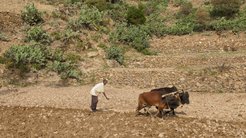Guardians of Productive Landscapes
Ivo Strecker

Update on the project
GUARDIANS OF PRODUCTIVE LANDSCAPES - FILM SERIES
as of June 2019
Editor: Ivo Strecker
Introduction by David MacDougall
The Guardians of Productive Landscapes Film Series is a major new initiative in applied anthropology. It calls for nothing less than a reorientation of global attitudes toward subsistence agriculture and pastoralism – a view that contests the received wisdom of capitalist ‘development’ and underlines the crucial role of the traditional farmer and pastoralist in maintaining the planet’s environmental health and diversity. Its most singular feature is that it argues not from theories but from empirical observation, and it presents its findings in a form that is universally accessible - for films, unlike texts, have the capacity to speak across cultural, educational, and linguistic boundaries. This series can play an important part in showing how traditional farmers and herders act as productive custodians of the land they have used for generations, and hope to use for generations to come. By concentrating its attention on the highly varied landscapes and cultures of Ethiopia, the series also creates a comprehensive study of a country exhibiting many of the climatic and geophysical conditions found throughout the world.
Introduction by Ivo Strecker
This film series is part of the broader "Guardians of Productive Landscapes" (GPL) project developed by the Department of Integration and Conflict at the Max Planck Institute for Social Anthropology, Halle/Saale, Germany; director Prof. Dr. Guenther Schlee. The ethnographic films on specific agricultural and pastoral traditions do not replicate written texts but are artistically constructed around the central theme of people's dedication to their landscape.
The films can be seen as a contribution to an applied anthropology, which tunes in with the growing public awareness that a host of environmental developments are threatening the earth. As Jared Diamond has scholarly argued and vividly evoked in Collapse. How societies choose to fail or survive (2005), today humanity is at the crossroads where life as we know it will soon cease unless we muster all our ingenuity for inward and outward persuasion to find ways to combat these vicissitudes.
Because vicissitudes are "unanticipated and beyond routine" they constitute an immense challenge: They "test the nature and limits of cultural resources", writes Michael Carrithers in his introduction to Rhetoric, culture and the vicissitudes of life (2009) and therefore "call up inventive answers, and, in so doing, demonstrate the very nature of both culture and the human imagination". The series is informed by this rhetorical theory of culture change and understands the use of film accordingly as a rhetorical venture (www.berghahnbooks.com/series/?pg=rhet_cult) that helps urge the global public to re-think and reform the relationship that until now has prevailed between subsistence and capitalist economies.
Currently an estimated one and a half billion people practise subsistence agriculture that produces about fifty per cent of the domestic food consumed in the developing world. The series shows how such a mode of production involves only human and animal labour, and only local resources. Being non-poisoning, non-destructive, bio-diverse, and sustainable it makes an invaluable contribution to the preservation of the biosphere.
In the light of this, the films produced in the series may lead audiences to better appreciate the positive role of these "guardians of productive landscapes" and help to establish the foundation for new policy initiatives that treat these subsistence farmers as partners in a joint struggle to save the endangered planet. The GPL project explores the constraints and enabling conditions for such a partnership.
Work on the series has begun in Ethiopia – a country with particularly rich natural and cultural diversity – but it is meant to expand and cover also other parts of the world like those described in the seminal FAO document by Parvis Koohaftan and Miguel A. Altieri (2011) entitled Globally important agricultural heritage systems. A legacy for the future (GIAHS). Ultimately, the GPL film series understands itself as a contribution to the initiative of the United Nations Convention on Biological Diversity (CBD), which calls on international obligations to respect and support the cultural heritage and customary use of biological resources practiced by local communities throughout the world.
Overview of films
Completed
(1) Abraham & Sarah Part I: Creators of a productive landscape (2017)
By Ivo Strecker
(2) Dancing Grass. Harvesting teff in the Tigrean highlands (2018)
By Mitiku Gabrehiwot
(3) In Aiyes's garden. Processing enset in the Gamo highlands (2019)
By Eyob Defersha
(4) Abraham & Sarah Part II: The Gundagundo pilgrimage (2019)
By Tesfahun Haddis
(5) Family subsistence in the Hamar hills (2019)
By Jean Lydall and Kaira Strecker
Work in progress (filming has begun)
(6) There is work tomorrow! Farming the highlands of southern Ethiopia.
By Eyob Defersha and Emebet Demelash
(7) Floods, fields and meadows. Sharing land among the Arbore.
By Echi Gabbert and Gino Ballo
(8) Milking the ‘Chobui’ Tree. How the pastoral Mun relish the fruits of the forest.
By Shauna LaTosky and Oliserale
(9) Talking highlands. Memories in the ancient landscapes of Tigray.
By Wolbert Smidt
(10) Abraham & Sarah Part III: The grace of subsistence.
By Selamawit Hailu
In preparation (research completed or begun)
(11) Tamed water. Dassanech modes of subsistence in the delta of the Lower Omo.
By Konrad Licht
(12) The tulaa wells. The ritual and social making of a pastoral landscape
Care of Marco Bassi.
(13) A troubled park. Game wardens, herders and hunters in collision.
By Yohannes Yitbarek
